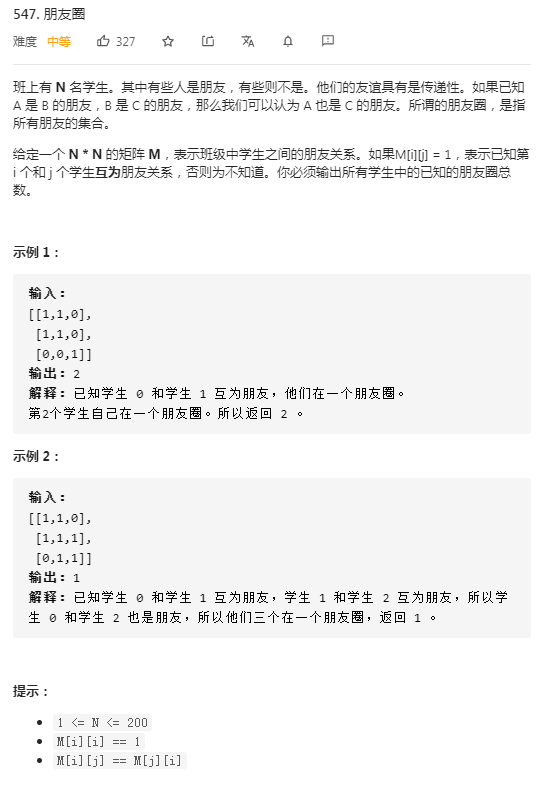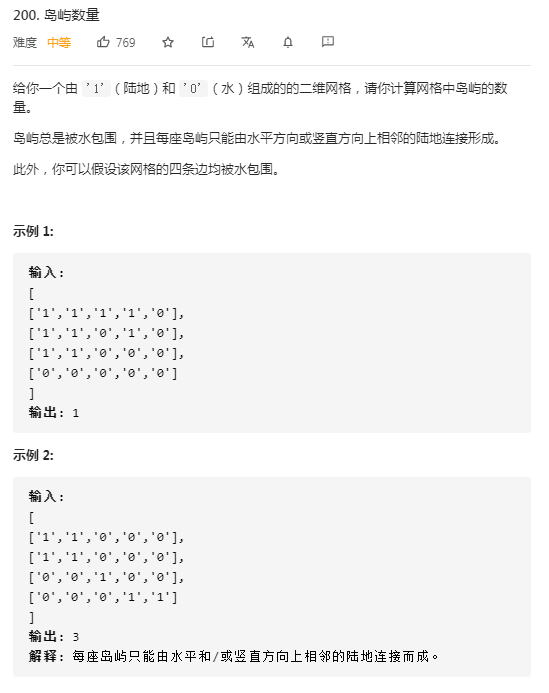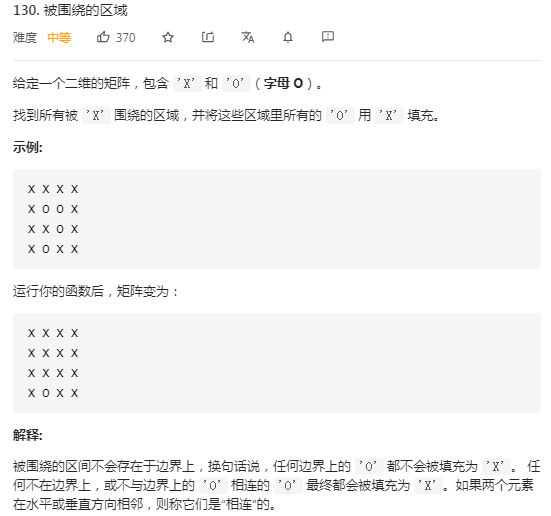标签:连通 用法 ref nec UNC oss 实例 ons 子集合
在计算机科学中,并查集是一种树型的数据结构,用于处理一些不交集(Disjoint Sets)的合并及查询问题。有一个联合-查找算法(Union-find Algorithm)定义了两个用于此数据结构的操作:
由于支持这两种操作,一个不相交集也常被称为联合-查找数据结构(Union-find Data Structure)或合并-查找集合(Merge-find Set)。
type UnionFind struct {
count int
parent []int
}
func ctor(n int) UnionFind {
uf := UnionFind{
count: n,
parent: make([]int, n),
}
for i := 0; i < n; i++ {
uf.parent[i] = i
}
return uf
}
func (uf *UnionFind) find(p int) int {
for p != uf.parent[p] {
uf.parent[p] = uf.parent[uf.parent[p]] // 路径压缩
p = uf.parent[p]
}
return p
}
func (uf *UnionFind) union(p, q int) {
rootP, rootQ := uf.find(p), uf.find(q)
if rootP == rootQ {
return
}
uf.parent[rootP] = rootQ
uf.count--
}

题目分析:
题目求的是有多少个朋友圈,也就是求有集合个数,可用并查集解决。
两重遍历所有学生,判断俩俩是否为朋友,如为朋友将加入到集合中。这里可以通过遍历二维矩阵的右半边即可,可降低遍历数量,从而降低时间复杂度。
代码实现:
func findCircleNum(M [][]int) int {
n := len(M)
uf := ctor(n)
// 遍历学生 i, j ,if M[i][j]==1 加入集
for i := 0; i < n; i++ {
for j := i + 1; j < n; j++ {
if M[i][j] == 1 {
uf.union(i, j)
}
}
}
// 再返回有多少个集合
return uf.count
}
type UnionFind struct {
parents []int
count int
}
func ctor(n int) UnionFind {
uf := UnionFind{
parents: make([]int, n),
count: n,
}
for i := 0; i < n; i++ {
uf.parents[i] = i
}
return uf
}
func (uf *UnionFind) find(p int) int {
for p != uf.parents[p] {
uf.parents[p] = uf.parents[uf.parents[p]]
p = uf.parents[p]
}
return p
}
func (uf *UnionFind) union(p, q int) bool {
rootP, rootQ := uf.find(p), uf.find(q)
if rootP == rootQ {
return false
}
uf.parents[rootP] = rootQ
uf.count--
return true
}
复杂度分析:
uf.union 和 uf.find 的时间复杂度为 \(O(1)\) ,所以总的时间复杂度为 \(O(n^2)\)。
题目分析:
题目求的是岛屿数量,即集合个数,可用并查集解决。
题目可抽象为遍历所有网格 (i, j),如果是陆地((i, j) == ‘1‘),则把其右边的陆地((i+1, j) == ‘1‘)和下边的陆地((i, j+1) == ‘1‘)合并到一起;如是水((i, j) == ‘0‘),则把其合并到一个哨兵集合里。最后返回 集合个数 - 1。
注:这里关键是对于水的处理,把其合并到一个哨兵集合里,让水不会单独存在,从而干扰岛屿个数的判断。
代码实现:
func numIslands(grid [][]byte) int {
rows := len(grid)
if rows == 0 {
return 0
}
cols := len(grid[0])
if cols == 0 {
return 0
}
uf := ctor(rows*cols + 1)
guard := rows * cols // 哨兵:用于作为 ‘0‘ 的集合
directions := [][]int{[]int{0, 1}, []int{1, 0}}
for i := 0; i < rows; i++ {
for j := 0; j < cols; j++ {
index := i*cols + j
if grid[i][j] == ‘1‘ {
for _, direction := range directions {
newI, newJ := i+direction[0], j+direction[1]
if newI < rows && newJ < cols && grid[newI][newJ] == ‘1‘ {
newIndex := newI*cols + newJ
uf.union(index, newIndex)
}
}
} else {
uf.union(guard, index)
}
}
}
return uf.count - 1
}
type UnionFind struct {
parents []int
count int
}
func ctor(n int) UnionFind {
uf := UnionFind{parents: make([]int, n), count: n}
for i := 0; i < n; i++ {
uf.parents[i] = i
}
return uf
}
func (uf *UnionFind) find(p int) int {
for p != uf.parents[p] {
uf.parents[p] = uf.parents[uf.parents[p]]
p = uf.parents[p]
}
return p
}
func (uf *UnionFind) union(p, q int) bool {
rootP, rootQ := uf.find(p), uf.find(q)
if rootP == rootQ {
return false
}
uf.parents[rootP] = rootQ
uf.count--
return true
}
复杂度分析:
n 和 m 分别表示二维数组的行数和列数。n * m 大小的数组空间。
题目分析:
题目可理解为把边界上的 ‘O‘ 保留,其他都填充为 ‘X‘ ,可以把边界上的 ‘O‘ 作为一个集合,不是这个集合的填充为 ‘X‘ ,因此可使用并查集解决。
‘O‘ 合并到一个哨兵集合里。‘O‘ 的右和下合并到一起。‘X‘代码实现:
func solve(board [][]byte) {
n := len(board)
if n == 0 {
return
}
m := len(board[0])
if m == 0 {
return
}
uf := ctor(n*m + 1)
guard := n * m
directions := [][]int{[]int{0, 1}, []int{1, 0}}
getIndex := func(i, j int) int {
return i*m + j
}
// 1. 遍历边界上的点,把 ‘O‘ 合并到一个哨兵集合里。
for j := 0; j < m; j++ {
if board[0][j] == ‘O‘ {
uf.union(getIndex(0, j), guard)
}
if board[n-1][j] == ‘O‘ {
uf.union(getIndex(n-1, j), guard)
}
}
for i := 0; i < n; i++ {
if board[i][0] == ‘O‘ {
uf.union(getIndex(i, 0), guard)
}
if board[i][m-1] == ‘O‘ {
uf.union(getIndex(i, m-1), guard)
}
}
// 2. 遍历二维矩阵里的点,把 ```‘O‘``` 的右和下合并到一起。
for i := 0; i < n; i++ {
for j := 0; j < m; j++ {
if board[i][j] == ‘O‘ {
for _, direction := range directions {
newI, newJ := i+direction[0], j+direction[1]
if newI < n && newJ < m && board[newI][newJ] == ‘O‘ {
uf.union(getIndex(newI, newJ), getIndex(i, j))
}
}
}
}
}
// 3. 遍历二维矩阵,把不在哨兵集合里的全部填充为 ‘X‘
for i := 0; i < n; i++ {
for j := 0; j < m; j++ {
if !uf.isConnect(getIndex(i, j), guard) {
board[i][j] = ‘X‘
}
}
}
}
type UnionFind struct {
parents []int
count int
}
func ctor(n int) UnionFind {
uf := UnionFind{
parents: make([]int, n),
count: n,
}
for i := 0; i < n; i++ {
uf.parents[i] = i
}
return uf
}
func (uf *UnionFind) find(p int) int {
for p != uf.parents[p] {
uf.parents[p] = uf.parents[uf.parents[p]]
p = uf.parents[p]
}
return p
}
func (uf *UnionFind) union(p, q int) bool {
rootP, rootQ := uf.find(p), uf.find(q)
if rootP == rootQ {
return false
}
uf.parents[rootP] = rootQ
uf.count--
return true
}
func (uf *UnionFind) isConnect(p, q int) bool {
return uf.find(p) == uf.find(q)
}
复杂度分析:
n 和 m 分别表示二维数组的行数和列数。n * m 大小的数组空间。200. 岛屿数量 和 130. 被围绕的区域。200. 岛屿数量 和 130. 被围绕的区域。标签:连通 用法 ref nec UNC oss 实例 ons 子集合
原文地址:https://www.cnblogs.com/liang24/p/13690759.html